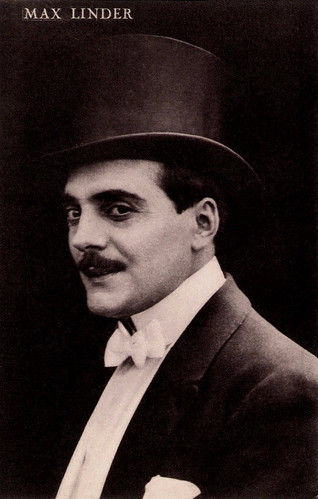
French postcard by Helio Paul et Vigier, Paris. Publicity card for the Pathé-Baby projector.
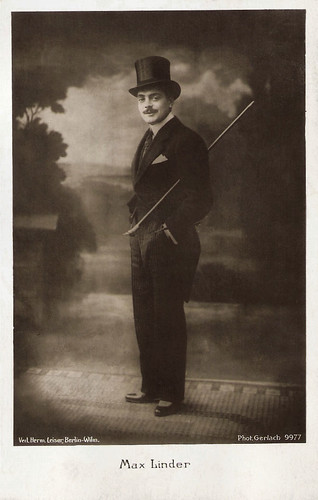
German postcard by Verlag Herm. Leiser, no. 9977. Photo: Gerlach.
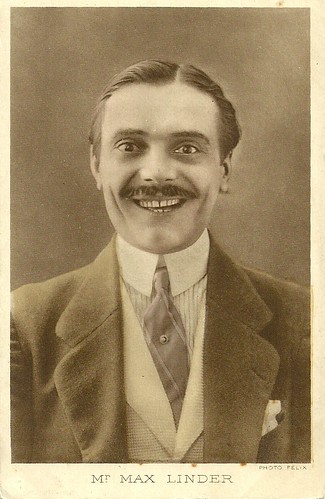
French postcard by Pathé Frères. Photo: Felix.
Gentleman Max
Max Linder was born Gabriel-Maximilien Leuvielle in Saint-Loubès, France in 1883 to a Jewish wine-growing family.
He grew up with a passion for the stage and at 17 he dropped out of school in order to join a touring theatre troupe, which did not please his parents.
While working in Paris as an actor in the theatre and vaudeville, Leuvielle became fascinated with motion pictures. In 1905 he took a job with Pathé Frères and in the following years, he became a comedic actor, director, screenwriter, as well as a producer under the stage name, Max Linder.
His debut was Première sortie/His First Night Out (Louis J. Gasnier, 1905). He created what was probably the first identifiable film character: ‘Max’, an elegant, joyful, romantic, top-hatted dandy.
Max appeared for the first time in Debuts d'un patineur/The Unskillful Skater (Louis J. Gasnier, 1907) and would return in successive situation comedies. ‘Gentleman Max’ was frequently in hot water because of his penchant for beautiful women and the good life.

French postcard for La légende de Polichinelle (Albert Capellani, Pathé frères 1907). With Max Linder as Polichinelle. Théâtre Pathé Grolée, Lyon. Polichinelle is an automaton in love with a cute doll in the same shop. When the doll is sold, a fairy helps Polichinelle following her and after a series of wild adventures he arrives at the house of the buyer just in time to save the doll from being burned.
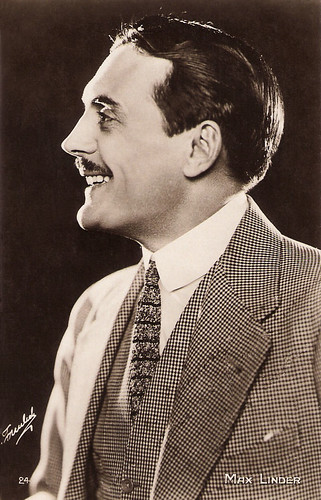
French postcard by Cinémagazine, no. 24.

French postcard by Cinémagazine, no. 188. Max Linder in Max der Zirkuskönig/King of the Circus (Édouard-Émile Violet, 1924).
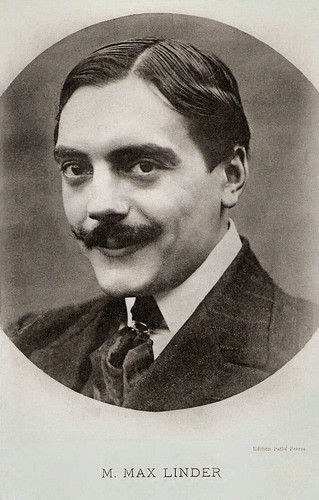
French postcard by Edition Pathé Frères.
Comedy Star No. 1
After comedian André Deed went to Italy, Max Linder moved up and became the comedy star no. 1 for Pathé.
In 1910 he shot one comedy each week. By 1911, Linder was directing all his own films as well as writing the script and the universality of silent films brought Linder fame and fortune throughout Europe. By 1912, he was the highest-paid film star in the world, with an unprecedented salary of one million francs.
His success didn't have any limits: whether Spain, Germany, Italy, or Russia, Max Linder was everywhere welcomed with enthusiasm during his live entrances in the capital cities. In Russia, the police had to call the Army for help so that Linder was able to leave the Moscow railroad station.
One of the best and more successful examples of his type of humour is the one-reeler Max et l'inauguration de la Statue/The Living Statue (Max Linder, 1912). Max attends a costume ball, dressed in a suit of armour. After drinking too much at the party, he passes out on the sidewalk. Meanwhile, during the evening, a new suit of armour to be unveiled at the Louvre the next day is stolen by a pair of thieves. The police, discovering the theft, stumbles upon Max. They take him back to the Louvre where he is unveiled for the Museum committee. They depart, whereupon the thieves return, take Max, and, back in the hideout, attempt to open the armour with tools. Max awakens, scares the burglars, then, in the final frame, strolls away, strumming a guitar.
The weekly adventures of Max were impatiently awaited by faithful and enthusiastic audiences. In 1914 Linder decided to realise one of his old dreams: to start a cinema. He bought a cinema in Paris with 1,200 seats, created in 1912, the Kosmorama. The Ciné Max Linder opened in December 1914.
World War I brought a temporary end to Linder's career in film. Physically unfit for combat duty, he worked as a dispatch driver during the war until he was seriously wounded. He was gassed, and the illness that resulted would blight his career.
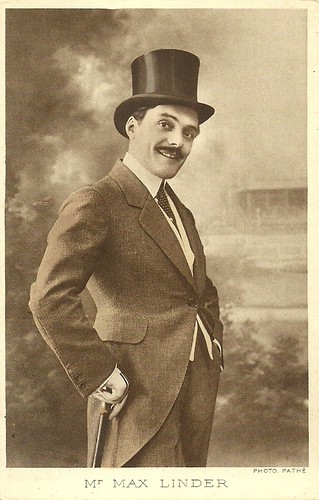
French postcard. Photo: Pathé.
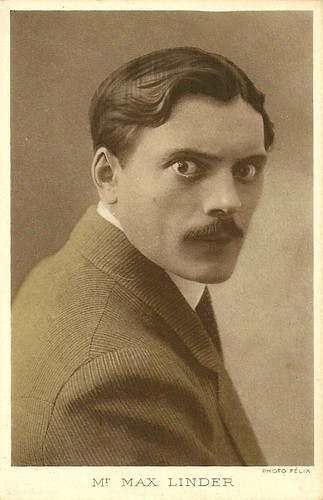
French postcard by Pathé Frères. Photo: Felix.
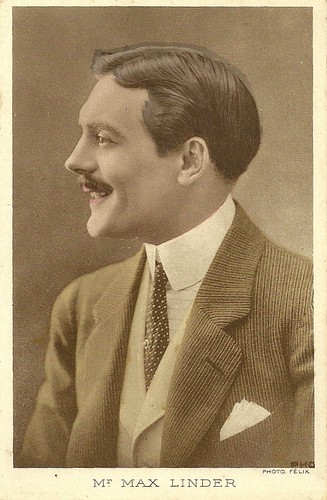
French postcard by Pathé Frères. Photo: Felix.
America
While in the hospital in 1916, Max Linder was visited by H.A. Spoor, a nephew of the president of Essanay films, G.K. Spoor. Having lost Charlie Chaplin, Spoor wanted Linder to "take his place" and offered him $5,000 per week to write, direct, and star in 12 three-reel comedies to be made in the studio's Chicago location.
Linder went to the US, but his first few American-made Max films didn't make the same impression as the Chaplin shorts. Recurring ill-health meant that his US films had little of the sparkle of his early French work. After only three films were completed Linder headed back to France.
For the convalescence of his pleurisy, Linder went to the lake of Geneva. In 1919 it seemed like Max was his old self again and his screen version of Le petit café/The Little Café (Raymond Bernard, 1919) was received enthusiastically by critics and audiences on both sides of the Atlantic.
He made another attempt at filmmaking in the US for the recently-formed United Artists (one of whose founders was Charles Chaplin). He worked as a film producer, screenwriter, director, and leading actor on three films: Seven Years Bad Luck (Max Linder, 1921), Be My Wife (Max Linder, 1921), and the film he considered his best, the inventive parody The Three Must-Get-Theres (Max Linder, 1922).
Endowed with overflowing imagination, he filled his films with an inexhaustible variety of gags. For example, Max was the first filmmaker to use the genius mirror gag in Seven Years Bad Luck, which the Marx Brothers used again so memorably in their film Duck Soup (Leo McCarey, 1933).
However, the work exhausted Max, and after finishing the last film he left the United States once again. Back in France, he appeared in only two more films. In Au Secours!/Help! (Abel Gance, 1923) he played a tragic part.
His last film, Der Zirkuskönig/King of the Circus (Max Linder, Édouard-Émile Violet, 1924) with Vilma Bánky, was made in Vienna, Austria. For the film Chevalier Barkas/The Knight Barkas he contacted the then-unknown director René Clair. But the film would never be realised.
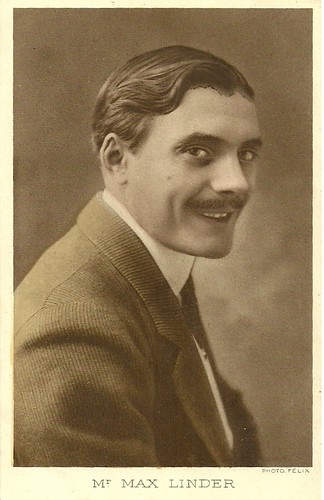
French postcard by Pathé Frères. Photo: Felix.
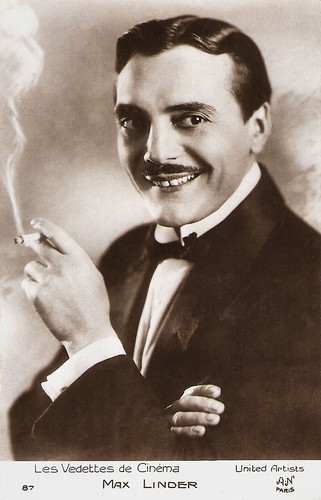
French postcard by A.N, Paris in the Les Vedettes de Cinéma series, no. 87. Photo: United Artists.

Italian postcard by Casa Editrice Ballerini & Fratini, Firenze, no. 787.
Suicide pact
The after-effect of Max Linder's war service was that he suffered from continuing health problems including bouts of severe depression.
In 1923, he married the 18-years old Hélène Peters, with whom he had a daughter, Maud. In the same year, he sold his Max Linder cinema.
The emotional problems besetting Linder evidenced themselves when he and his wife made a suicide pact. In early 1924 they attempted suicide at a hotel in Vienna, Austria. They were found and were recuperated, but on 31 October 1925 Linder and his wife were successful in taking their lives in Paris.
After Linder's death, Chaplin dedicated one of his films: "For the unique Max, the great master - his student Charles Chaplin". But in the ensuing years, Max Linder was relegated to little more than a footnote in film history.
In 1963, a compilation film titled En compagnie de Max Linder/Laugh with Max Linder was released. Later his daughter made a documentary film titled L'homme au chapeau de soie/The Man in the Silk Hat (Maud Linder, 1983). Max Linder's comic gestures, planned expressions, anachronisms, contrasts, and use of the unexpected, as well as his comic chase scenes (pursuits), became again the inspiration for young comedians.
Max Linder appeared in more than 400 films, mostly short comedies. Only about 80 survive. His daughter and the keeper of his heritage, Maud Linder, passed away on 25 October 2017).
Clip with Max Linder and Maurice Tourneur in Champion de boxe/Boxing Champion (1910). Source: TheBzzz (YouTube).
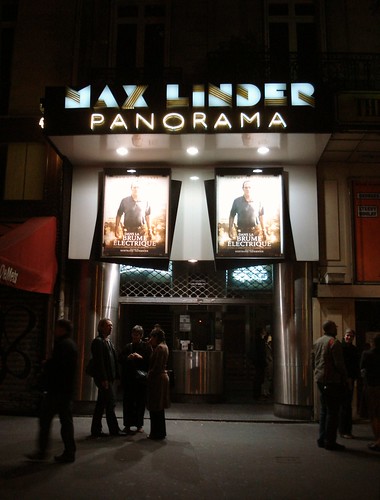
A May 2009 photo of the Max Linder cinema in Paris.
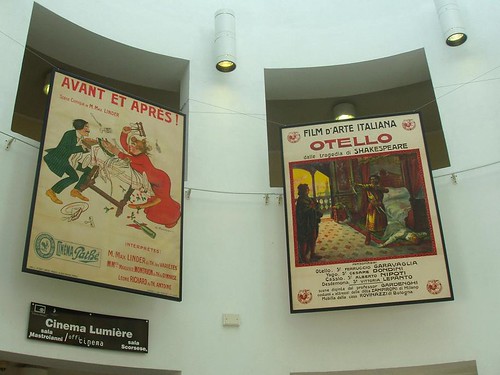
Left a poster for the Max Linder comedy Avant et après/Before and After, exhibited at the Cinema Ritrovato festival 2009. Atrium of the Lumiere cinema, Bologna, Italy.

Italian postcard by Le Giornate del Cinema Muto / La Cineteca del Friule / Cinemazero. Photo: Max Linder and Vilma Banky in Der Zirkuskönig/King of the Circus (Max Linder, Édouard-Émile Violet, 1924).
Sources: Lisa Stein Haven (The Rise & Fall of Max Linder), Thomas Staedeli (Cyranos), Michael Brooke (IMDb), Wikipedia, Golden Silents, and IMDb.
This post was last updated on 9 October 2021.
13 comments:
Another great postcard. It's rare to see and receive black & white postcard nowadays. You are great too. I salute for every effort you take writing a complete and informative information behind the postcard. Keep it up!
Hi Bob
Thank you for introducing me to the Great Max Linder.
He is such an amazing man.
What an incredible amount of information you found.
Happy Postcard Friendship Friday to you .
Again thank you so very much for sharing all the wonderful detailed information .
I so look forward to Fridays knowing I am going to learn something new .
It is always so much fun.
Have a wonderful weekend.
Happy Trails
reminds me of charlie chaplin a lot. perhaps the top hat and curly moustache was all the rage with comedians then?
Unbelievable Blog!!! - well I love movies, and there is an incredible wealth of info and interesting nuggets here. I will spend hours exploring.
Post Script (pun intended) - My Auntie used to get cards in cigarette packets featuring movie stars and I still remember cards featuring Dean Martin and Randolph Scott...
Thank you for visiting my blog and leaving comments.
I don't know many of those film stars you have posted. I remember watching Charlie Chaplin and the 3 Stooges when I was very young.
thank you for sharing with us.
My Mom confessed that she is now a youtube -aholic! :) She visits your blog, watches all of the clips that accompany the fascinating history, and then gets losttt on youtube as she gulps down more and more videos from each featured star! Hooray for you Bob!
Gentleman Max, what a lovely name! It's interesting how international he was, much more than nowadays.
Fascinating as always .. thank you, Bob, for all the time you take to present the history of these wonderful cards .. glimpses into the past!
WOW!!! Another fabulous card and Max Linder is awesome. Thanks for sharing.
debby
That's a great postcard! I had never heard of Max linder before...very interesting. Thanks for all the info.
Oh, and I agree with you son...Dumbo is a great movie! It was one of my favorites as a kid!
What an interesting life some of these folks lead. A suicide pact? a young bride, a replacement for Charlie Chaplin & was the first to do the mirror act? Very very interesting. Thanks for writing as much as you do about these fascinating people.
As always, a fabulous post. I am always glad I stopped by.
Great postcard...and I truly enjoyed the films. I knowing only of Chaplin's work, thought it interesting how he, like Chaplin, strutted along swinging a cane and with mustache and hat as well. Then after reading on and finding Chaplin thought him the master, I tend to think that Chaplin must have studied Max Linder's work and even may have stole from him.
It's a bit sad that someone of such great talent should have it all end so tragically.
Thank you once again.....and have a most beautiful weekend.
Thank you all for stopping by - especially Marie's mother. I hope to meet you again at next PFF!
Post a Comment